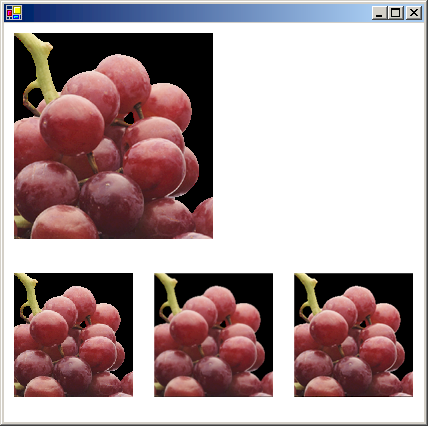Vorgehensweise: Verwenden des Interpolationsmodus zum Steuern der Bildqualität während der Skalierung
Der Interpolationsmodus eines Graphics-Objekts beeinflusst die Art und Weise, wie GDI+ Bilder skaliert (streckt und verkleinert). Die InterpolationMode-Enumeration definiert mehrere Interpolationsmodi, von denen einige in der folgenden Liste gezeigt werden:
Um ein Bild zu strecken, muss jedes Pixel im Originalbild einer Gruppe von Pixeln im größeren Bild zugeordnet werden. Um ein Bild zu verkleinern, müssen Gruppen von Pixeln im Originalbild einzelnen Pixeln im kleineren Bild zugeordnet werden. Die Effektivität der Algorithmen, die diese Zuordnungen vornehmen, bestimmt die Qualität eines skalierten Bilds. Algorithmen, die skalierte Bilder von höherer Qualität erzeugen, erfordern tendenziell mehr Verarbeitungszeit. In der vorherigen Liste ist NearestNeighbor der Modus mit der niedrigsten Qualität und HighQualityBicubic der Modus mit der höchsten Qualität.
Weisen Sie zum Festlegen des Interpolationsmodus einen der Member der InterpolationMode-Enumeration der InterpolationMode-Eigenschaft eines Graphics-Objekts zu.
Beispiel
Im folgenden Beispiel wird ein Bild gezeichnet und anschließend mit drei verschiedenen Interpolationsmodi verkleinert.
Die folgende Abbildung zeigt das Originalbild und die drei kleineren Bilder.

Image image = new Bitmap("GrapeBunch.bmp");
int width = image.Width;
int height = image.Height;
// Draw the image with no shrinking or stretching.
e.Graphics.DrawImage(
image,
new Rectangle(10, 10, width, height), // destination rectangle
0,
0, // upper-left corner of source rectangle
width, // width of source rectangle
height, // height of source rectangle
GraphicsUnit.Pixel,
null);
// Shrink the image using low-quality interpolation.
e.Graphics.InterpolationMode = InterpolationMode.NearestNeighbor;
e.Graphics.DrawImage(
image,
new Rectangle(10, 250, (int)(0.6 * width), (int)(0.6 * height)),
// destination rectangle
0,
0, // upper-left corner of source rectangle
width, // width of source rectangle
height, // height of source rectangle
GraphicsUnit.Pixel);
// Shrink the image using medium-quality interpolation.
e.Graphics.InterpolationMode = InterpolationMode.HighQualityBilinear;
e.Graphics.DrawImage(
image,
new Rectangle(150, 250, (int)(0.6 * width), (int)(0.6 * height)),
// destination rectangle
0,
0, // upper-left corner of source rectangle
width, // width of source rectangle
height, // height of source rectangle
GraphicsUnit.Pixel);
// Shrink the image using high-quality interpolation.
e.Graphics.InterpolationMode = InterpolationMode.HighQualityBicubic;
e.Graphics.DrawImage(
image,
new Rectangle(290, 250, (int)(0.6 * width), (int)(0.6 * height)),
// destination rectangle
0,
0, // upper-left corner of source rectangle
width, // width of source rectangle
height, // height of source rectangle
GraphicsUnit.Pixel);
Dim image As New Bitmap("GrapeBunch.bmp")
Dim width As Integer = image.Width
Dim height As Integer = image.Height
' Draw the image with no shrinking or stretching. Pass in the destination
' rectangle (2nd argument), the upper-left corner (3rd and 4th arguments),
' width (5th argument), and height (6th argument) of the source
' rectangle.
e.Graphics.DrawImage( _
image, _
New Rectangle(10, 10, width, height), _
0, _
0, _
width, _
height, _
GraphicsUnit.Pixel, _
Nothing)
' Shrink the image using low-quality interpolation.
e.Graphics.InterpolationMode = InterpolationMode.NearestNeighbor
' Pass in the destination rectangle, and the upper-left corner, width,
' and height of the source rectangle as above.
e.Graphics.DrawImage( _
image, _
New Rectangle(10, 250, CInt(0.6 * width), CInt(0.6 * height)), _
0, _
0, _
width, _
height, _
GraphicsUnit.Pixel)
' Shrink the image using medium-quality interpolation.
e.Graphics.InterpolationMode = InterpolationMode.HighQualityBilinear
' Pass in the destination rectangle, and the upper-left corner, width,
' and height of the source rectangle as above.
e.Graphics.DrawImage( _
image, _
New Rectangle(150, 250, CInt(0.6 * width), _
CInt(0.6 * height)), _
0, _
0, _
width, _
height, _
GraphicsUnit.Pixel)
' Shrink the image using high-quality interpolation.
e.Graphics.InterpolationMode = InterpolationMode.HighQualityBicubic
' Pass in the destination rectangle, and the upper-left corner, width,
' and height of the source rectangle as above.
e.Graphics.DrawImage( _
image, _
New Rectangle(290, 250, CInt(0.6 * width), CInt(0.6 * height)), _
0, _
0, _
width, _
height, _
GraphicsUnit.Pixel)
Kompilieren des Codes
Das obige Beispiel ist für die Verwendung in Windows Forms konzipiert und erfordert PaintEventArgse, einen Parameter des Paint-Ereignishandlers.
Siehe auch
.NET Desktop feedback
Feedback
Bald verfügbar: Im Laufe des Jahres 2024 werden wir GitHub-Issues stufenweise als Feedbackmechanismus für Inhalte abbauen und durch ein neues Feedbacksystem ersetzen. Weitere Informationen finden Sie unter https://aka.ms/ContentUserFeedback.
Feedback senden und anzeigen für
